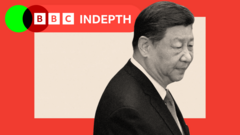China appears relatively unfazed by President Trump's substantial tariffs, which have instead sparked a wave of nationalistic humor in online memes. Amid trade tensions, Xi Jinping remains unyielding, asserting China’s historical reliance on self-sufficiency. Despite pursuing economic progress, Xi's vision of rejuvenation encounters significant hurdles rooted in domestic issues rather than solely in the trade conflict with the U.S.
While the Chinese populace theoretically comprises a massive market, economic uncertainty curtails consumer spending. The recent collapse of the housing market has left many families reeling, causing a decline in consumer confidence after years of investment turning futile. Ghost cities with unoccupied apartments symbolize the overwhelming excess of supply. Though the government has restricted developer borrowing, the consequences of overbuilding have left little scope for change.
With increasing worries regarding pension sustainability and youth unemployment—over 20% among 16-24 urban dwellers—the outlook for domestic demand remains bleak. Experts underscore that transitioning from an export-led economy to one fueled by domestic consumption is a complex challenge that will require time.
Xi's stagnant economic plan coincides with a younger generation's dwindling hopes, potentially sowing grounds for social unrest—a troubling reality highlighted by rising protests related to economic hardships. Government efforts to revive the economy through subsidies and discounts have proven insufficient, as experts advocate for sustainable income increases for residents, long overdue for Xi's promises of prosperity.
Despite successes in technology and manufacturing, Xi navigates a landscape disrupted by U.S. sanctions aimed at curbing China’s technological ascendancy. However, the trade war has nudged China toward seeking diversified markets in Southeast Asia, Latin America, and Africa. Gradually, nations involved in the Belt and Road Initiative have strengthened trade relations and shifted financial dependencies away from the United States.
While opportunistic in the face of U.S. tariffs, Xi's attempts to position China as a reliable global partner may be hindered by past actions against nations like Australia. Challenges persist regarding potential dumping of goods and ensuing competition, which might lead to further regional tensions.
As speculation mounts that Trump may soften his hardline stance on tariffs, China remains focused on long-term adjustments and remedies. The prior trade war has prompted China to rethink its foreign trade strategies, demonstrating resilience in face of adversity. The future will ultimately hinge on China's domestic policy adaptations, independent of external pressures from Washington.
While the Chinese populace theoretically comprises a massive market, economic uncertainty curtails consumer spending. The recent collapse of the housing market has left many families reeling, causing a decline in consumer confidence after years of investment turning futile. Ghost cities with unoccupied apartments symbolize the overwhelming excess of supply. Though the government has restricted developer borrowing, the consequences of overbuilding have left little scope for change.
With increasing worries regarding pension sustainability and youth unemployment—over 20% among 16-24 urban dwellers—the outlook for domestic demand remains bleak. Experts underscore that transitioning from an export-led economy to one fueled by domestic consumption is a complex challenge that will require time.
Xi's stagnant economic plan coincides with a younger generation's dwindling hopes, potentially sowing grounds for social unrest—a troubling reality highlighted by rising protests related to economic hardships. Government efforts to revive the economy through subsidies and discounts have proven insufficient, as experts advocate for sustainable income increases for residents, long overdue for Xi's promises of prosperity.
Despite successes in technology and manufacturing, Xi navigates a landscape disrupted by U.S. sanctions aimed at curbing China’s technological ascendancy. However, the trade war has nudged China toward seeking diversified markets in Southeast Asia, Latin America, and Africa. Gradually, nations involved in the Belt and Road Initiative have strengthened trade relations and shifted financial dependencies away from the United States.
While opportunistic in the face of U.S. tariffs, Xi's attempts to position China as a reliable global partner may be hindered by past actions against nations like Australia. Challenges persist regarding potential dumping of goods and ensuing competition, which might lead to further regional tensions.
As speculation mounts that Trump may soften his hardline stance on tariffs, China remains focused on long-term adjustments and remedies. The prior trade war has prompted China to rethink its foreign trade strategies, demonstrating resilience in face of adversity. The future will ultimately hinge on China's domestic policy adaptations, independent of external pressures from Washington.





















